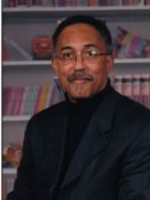
Larry Provette
Class of 1974, Architecture, Black Student Union Participant
March 4, 2020
“Anansi is a spider, an African spider, and this was the awakening of the spider, basically just saying that Pratt was awakening some community and people of African descent.”
Early Education
Larry Provette came to Pratt from one of the oldest and best academic high schools of pre-engineering and architecture in the state of Kentucky. His aunt had attended Pratt in the 1930s and encouraged him to attend.
The Black Student Union
Provette recalls the first student strike starting with the architecture school, and then “we came together and formed the Black Student Union…so on the campus, there was a real sense amongst the people of color that we needed to come together to support each other and with that we formed what’s called the Black Student Union, which is a little deceiving because it was made up not only of black students but there were Hispanic and Asian members in the Black Student Union at that time.”
The BSU students “locked down the campus” with “big boat chains” and then glued the doors shut between the buildings. Provette recalls that the president at the time, James B. Donovan, “realized how much support the black students had from the rest of the student body. So the school was shut down literally for about two weeks.” The president agreed to meet with the BSU which came up with a set of demands, including “to open its doors up to be more inclusive of the community than it was in, to have more minority representation on faculty, to have more recruitment of minorities and minority programs on campus to bring in more students. It also kind of called for his resignation, but that was kind of negotiated and was taken out.”
Black Student Union and Surveillance
Provette describes the reason for the demand for Donovan’s resignation, which included an FBI presence on campus and other police activity such as “the special unit from the New York City Police Department. They were called the red team” who were “up on the roofs of the buildings…with cameras taking photographs…keeping eyes and ears on us. As a result of that, we bonded together in groups because, like I said [the BSU] was a female dominated group…we’d have groups of three and have one male with them. It was that much paranoia and with people being followed and being observed, and we didn’t know where that was going to go.“
Provette recalls that activism took many forms, including the influence of Black artists and musicians, including Pratt students, who formed collectives, exhibited in new public spaces, and played in neighborhood jazz spots: “there was what they called a black cultural center that opened up in Brooklyn called the East…in association with musicians and music and artists and it was at 10 Claver Place, and they allowed black students from Pratt and the BSU to come to and exhibit and to work with their artists as well.” Provette also recalls that BSU members also participated in the Black Panther breakfast program at the East, that it was “about feeding disenfranchised people in the community, children, families, make sure they had breakfast before they went to school so that they could perform well in school.” BSU students also supported artists and musicians living in 185 and 195 Willoughby—”historically Black residences”—who protested Pratt’s proposal to purchase the buildings.
Summer Youth Program
Provette remembers the Summer Youth Employment Program on campus that had a precedent in 1969 called Anansi Awakening: “Anansi is a spider, an African spider, and this was the awakening of the spider, basically just saying that Pratt was awakening some community and people of African descent.” He remembers that the program grew to about 400 students from the community with Pratt students employed as instructors: “we had everything from the arts and dance…music, sports, college prep. It was an all-inclusive program which was taken over by what’s called the Central Brooklyn Model Cities program.” Some of the teachers, in addition to the Pratt students, came from the neighborhood art and music collectives; it was a connection with the community and the movements that were going on and the greater community in New York City, as well as what was going on on campus.” Provette recalls that eventually the summer program evolved into “the Benjamin Banneker high school on campus….and that now exists right down the road.”
Not long after he settled with the BSU, President Donovan died from a heart attack. Provette suggests that blame was placed on the BSU but “not just the BSU…all the activism [that] was going on….we weren’t the only ones that would be activists on campus. There were other groups, you know, that were pretty active and pretty vocal on campus.”